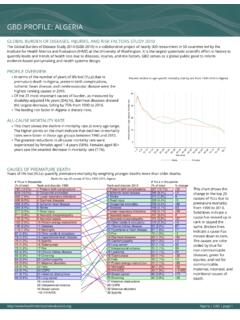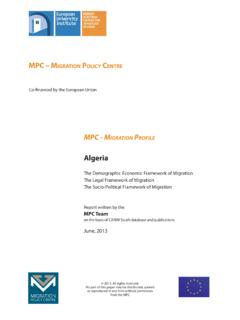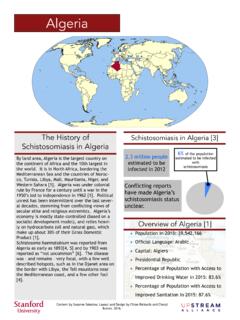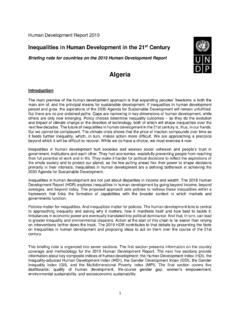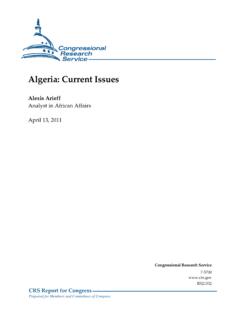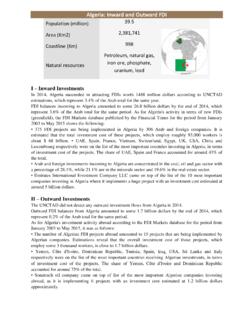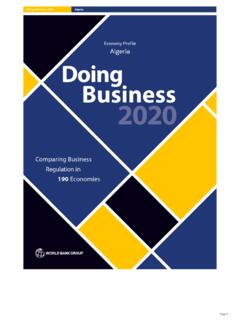Transcription of Algeria - UNHCR
1 Algeria AT A GLANCE. Main Objectives and Activities Complete preparatory activities for the voluntary repatriation of Western Saharan refugees under the UN Settlement Plan; pending the implementation of voluntary repa- triation, continue to provide assis- tance to vulnerable Western Saharan refugees in the Tindouf camps; provide protection and assistance to urban refugees of dif- ferent nationalities, and seek lasting solutions for them; promote refugee and humanitarian law, and work with government authorities to improve their capacity to adminis- Persons of Concern ter and manage refugee matters. Main Refugee Total Of whom Per cent Per cent Origin/Type of in UNHCR Female under 18. Impact Population Country assisted2. Western Sahara 165,0001 155,400 49 56. UNHCR completed core prepara- (Refugees). tory activities for the voluntary Palestinians (Refugees) 4,000 - - - repatriation of Western Saharan 1 This figure represents the total number of Western Saharan refugees according to Government statistics.
2 Refugees. A total of 129,863 2In addition, UNHCR assisted some 100 vulnerable urban refugees. refugees were pre-registered. UNHCR increased its presence Income and Expenditure (USD). within the camps, giving it full Annual Programme Budget access to the refugees. Revised Income Other Total Total Budget from Funds Funds Expenditure Anaemia among nursing mothers Contributions1 Available2 Available and women of child-bearing age 4,539,683 218,353 3,824,710 4,043,063 4,043,063. in the refugee camps was reduced 1. Includes income from contributions earmarked at the country level. 2 Includes allocations by UNHCR from unearmarked or broadly earmarked contributions, opening by 40 per cent; all significant balance and adjustments. cases of anaemia were treated. The above figures do not include costs at Headquarters. Eighty-six refugee women under- went training in various disci- plines, such as agriculture, computers and the appli- were provided for the nursing school to enhance its cation of solar energy technology.
3 Facilities and raise the level of instruction. During the school term, over 700 children between One water reservoir was built in Dakhla camp, result- the ages of six and 12 participated in extra-curricular ing in the provision of an acceptable amount of water activities designed to respond to their psycho-social for refugees in that camp. needs, and in the vacation months, another 1,400. The water quality was improved in three camps. children participated. Some 100 vulnerable urban refugees were assisted Several courses in vaccination, first aid and Spanish through financial aid and medical and educational were offered to health-care workers. Diverse materials services. 240 UNHCR Global Report 2000. WORKING ENVIRONMENT are in the desert and extremely difficult to control, with the result that it is fairly easy to enter the country at The Context unofficial border crossing points. Most routes between sub-Saharan Africa and the Mediterranean pass through Although Algeria is not a party in the conflict over the Algeria .
4 An increasing number of people are transiting Western Sahara Territory, the country has a deep interest via Tamanrasset in the south of Algeria in an effort to in the matter as it hosts some 165,000 refugees from the reach Europe. Among these are some refugees and a Territory (living in four camps in Tindouf, along Algeria 's considerable number of asylum-seekers. Other asylum- western border) and has observer status under the UN. seekers arrive from the Middle East and the Balkans. Settlement Plan for Western Sahara. The re-activation of Throughout 2000, a large number of asylum-seekers the Settlement Plan in 1997 called for UNHCR to approached UNHCR . There are currently some 400. recommence preparations to implement its tasks under refugees in the main urban centres of Algeria , of whom the Plan, namely the voluntary repatriation of identified roughly 100 are vulnerable persons who periodically voters and their immediate families. After several years of receive assistance from UNHCR .
5 Consultations, including direct talks between the two par- ties Morocco and the Frente Popular para la Liberaci n Constraints de la Sagu a el-Hamra y de R o de Oro (POLISARIO) key Repeated delays in the implementation of the Settle- political issues regarding the implementation of the ment Plan caused uncertainties that affected not only Settlement Plan remain unresolved. the preparations for voluntary repatriation but also assis- Pending a political solution, UNHCR maintained pre- tance activities in the camps. paredness for the possibility of voluntary repatriation The maintenance of infrastructure and equipment and completed core preparatory activities. Although (including vehicles and office buildings), which were repatriation did not take place, comprehensive pre- worn out by the harsh desert conditions, required registration was carried out in order to ascertain the resources that were not envisaged. Financial constraints refugees' willingness to repatriate and to determine their experienced by WFP resulted in difficulties in providing Algeria final destination in the Western Sahara Territory.
6 This basic food for the 155,400 vulnerable refugees. These exercise, which began in June 1997, was completed in difficulties, compounded by the delay in the implemen- October 2000. It was conducted in close co-operation tation of the Settlement Plan and voluntary repatriation, with the UN Mission for the Referendum in Western raised concerns for the welfare of the refugees, especially Sahara (MINURSO). Using the provisional list of voters the women and children. compiled by MINURSO, a total of 129,863 refugees were pre-registered. Following the completion of this UNHCR could not adequately monitor the needs of exercise and UNHCR 's statistical analysis, some 155,400 urban refugees, due to staff shortages and prevailing refugees, out of the 165,000 estimated by the insecurity in Algiers. Government, were identified as vulnerable refugees in need of assistance. Concurrently, UNHCR carried out a Funding needs assessment, gathering information on the refugees' Due to financial constraints, UNHCR had to reduce its personal effects and livestock in order to update the logis- assistance programme for the refugees to mainly life- tics Plan of Action.
7 UNHCR also planned to compile a sustaining activities. A project to increase the water demographic profile of the refugees by the end of the resources in Laayoune camp had to be discontinued. This year. However, due to understaffing, this activity was not affected some 40,000 refugees. Furthermore, several small completed and is still ongoing. projects in the sectors of health, sanitation, education and agriculture were put on hold (for all camps). In addition to its presence in Tindouf, UNHCR . increased its presence within the camps. The Office set ACHIEVEMENTS. up an operational base in the town of Rabouni (which A N D I M PAC T. is close to the Laayoune, Smara and Awserd camps) to cover 130,000 refugees. UNHCR also built a base Protection and Solutions inside the most isolated camp, Dakhla (160 km from Algeria is a party to the 1951 Convention and its 1967. Tindouf). This gave UNHCR greater access to the esti- Protocol, as well as the 1969 OAU Convention.
8 Asylum- mated 35,000 refugees there. seekers recognised by UNHCR as refugees are automati- Algeria is the second largest country in Africa and it cally recognised by the Algerian authorities. The Western shares a border with six countries. Most of the borders Saharan refugees living in the camps in Tindouf have been UNHCR Global Report 2000 241. considered to be refugees on a prima facie basis since reception, handling and distribution of basic humanitar- 1975. A durable solution for these refugees (voluntary ian assistance that arrived in the camps. They also set up repatriation) is directly linked to the successful implemen- committees focusing on health and sanitation issues. tation of the UN Settlement Plan. In preparation for Many of the women served as teachers in the schools and eventual voluntary repatriation, UNHCR carried out a most of the nurses were women. Young women were comprehensive pre-registration of all the Western Saharan assigned responsibility for running nurseries, day-care refugees and their immediate families, using voter infor- centres and similar activities for the benefit of children.
9 Mation from MINURSO. UNHCR gathered vital infor- UNHCR continued to monitor the refugee situation in mation on the true wishes of the refugees regarding repa- Tamanrasset and along the Algeria /Niger/Mali border triation, as well as information on their desired final where some 200 refugees still remain after the completion destination in the Western Sahara Territory. of the voluntary repatriation of 45,000 persons in 1998. As requested by the UN Department of Peacekeeping Some 100 new asylum-seekers approached UNHCR in Operations (DPKO) and MINURSO, UNHCR con- 2000, despite widespread insecurity in Algeria . tinued consulting with the parties on its proposed draft UNHCR continued to conduct refugee status determi- Plan of Action for Confidence-Building Measures, as nation interviews. Ninety people were recognised as presented to the UN Security Council in 1999 and refugees. Although the delicate security situation in the shared with the two parties. This plan was further dis- country did not affect the implementation of UNHCR 's cussed at a meeting in Geneva in 2000 but was not programme, it limited the movement of staff and the implemented, as the parties have not yet agreed on monitoring of urban refugees.
10 Implementation modalities. Nevertheless, some relevant information on UNHCR 's mandate and its role in the During the year, there was some contact and negotiation Settlement Plan was shared with the refugees during the with the authorities for the promotion of refugee law and pre-registration exercise in the camps, which was, in other relevant issues. UNHCR facilitated the training of itself, an important confidence-building measure. some key Algerian counterparts at the Ministry of Foreign Women continued to play a very active role in all aspects Affairs working with refugees and asylum-seekers at aca- of daily life in the camps. They were in charge of the demic institutions outside Algeria . The aim is to increase the capacity of the authorities to administer and manage month to combat dehydration and 200 grams of yeast refugee matters and to have a functioning refugee status per family per month to supplement the diet. determination body and legislation in the country.










